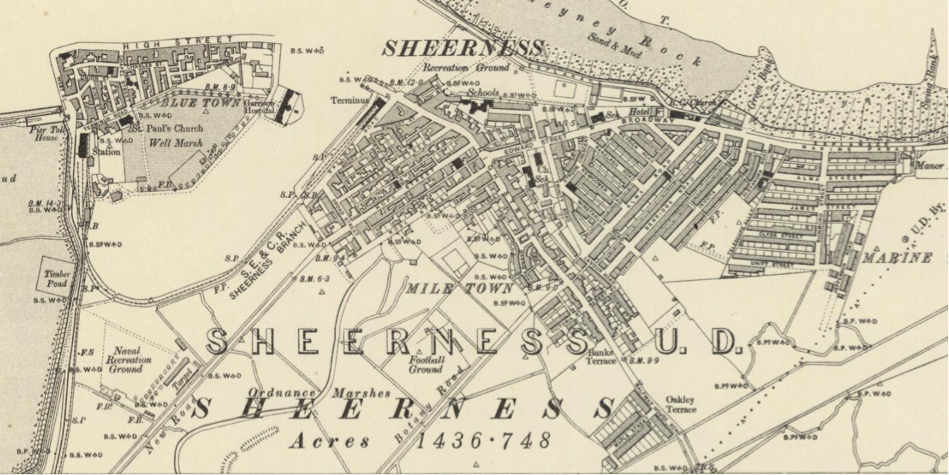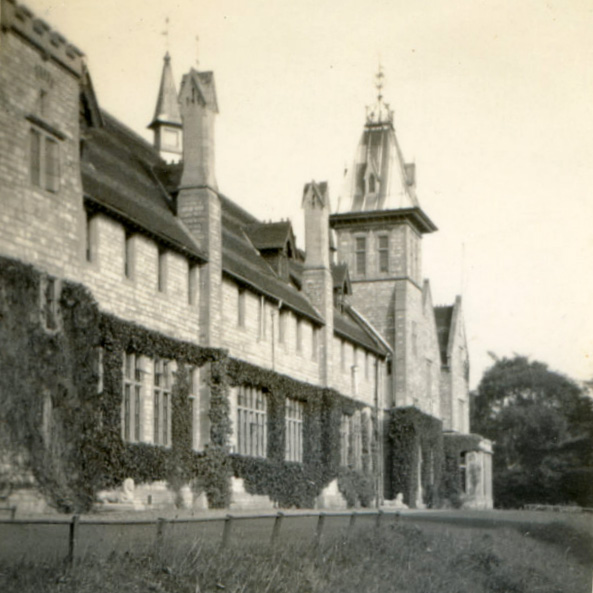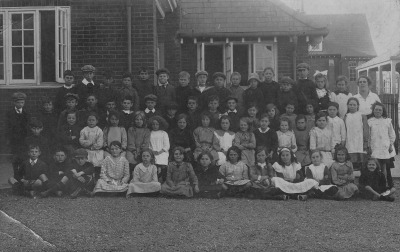William Herbert Carr
12th June 1886 – 20th September 1917
Company Sergeant Major William Herbert Carr, Regimental Number 320974, was killed in action on the Western Front near St. Julien on the 20th September 1917. He is commemorated on the Menin Gate, Belgium.
Family Background
WHC’s parents were William George Rendell1 (born 1858) and Helena Harriet Elizabeth, née Leach. George was a naval gunner and hailed from Tyneside. Life in the Navy could mean protracted periods away from home, but this was something Helena presumably understood from an early age as her father, James Leach (1837-1930), had been in the Royal Navy. Her mother is recorded as the head of household and ‘Seaman’s wife’ in 1861 and 1871.
Helena was born in Gosport, Hampshire, 350 miles distant. We do not know how they met but perhaps there is a pointer in the 1881 Census. It shows Helena as a ‘Visitor’, staying with a family in Tynemouth, at 9 Brewery Bank (now Brewhouse Bank, North Shields), overlooking the Tyne. Why she was there we do not know as the Armstrong family she was staying with has no traceable link with the Leaches.
Hardships and Celebrations
They married in Portsmouth towards the end of 1884. Their first child was William George Henry who was born in 1885 in Portsmouth but contracted jaundice 7 days after birth and died at the age of 8 weeks.
Helena and William George Rendell’s second child was born surprisingly soon after this tragedy. It was not uncommon to use the deceased’s name for a subsequent child and so a second William—William Herbert—arrived on Saturday, 12th June, 1886.
Daughter Helena Daisy followed on 20th September 1887, born in Portsmouth. The last of the Carr brood was Gladys Lilian, born in the Summer of 1894 at Portsmouth.
By 1901, the family had moved, following WGR’s naval posting, to Sheerness and was living in a bay-windowed yellow-brick house in Maple Street. Now part of the suburbs, in 1901 it was two isolated terraces separated from the small military town by Ordnance Marshes. We see there the first sign of William’s future career that would lead to his inclusion on the college memorial roll: at the age of 14 he had become a Pupil Teacher. His work in the Sheerness school could only lasted for a short time. At some time in 19022 it appears that the family moved back to the Portsmouth area and William transferred to a new Pupil Teacher post at Drayton Road Council School, Portsmouth where he would teach and learn the trade for three years.
William obviously had promise in his teaching apprenticeship and in 1904 he took up a new post as Assistant Teacher at Emsworth National School, just to the east of the Portsmouth and Havant conurbations. The school was a small mixed elementary with an attendance of around 150 pupils. In December 1905 he achieved a first class pass in his Preliminary Examination for the Elementary School Teachers’ Certificate. He also had been successful in the following additional subjects: Practical and Theoretical Inorganic Chemistry, Physiography, Mathematics, and Freehand and Geometrical Drawing.
The day after William’s 20th birthday, we read the sad news that his father was admitted to West Sussex County Lunatic Asylum, Chichester3 (13th June, 1906). We don’t know of the nature of WGR’s illness, or how long it had been presenting, though it appears he was still well enough to hold down his naval position in 1901 when he was stationed at Sheerness, Isle of Sheppey, Kent. His stay in the asylum was brief: the Admission Register records his death on 9th November, 1906.
Extract from Lunacy Patients Admission Register, 1846-1912
Winchester Training College 1908-1909
The college was a very positive experience for students in the Edwardian period. It was a mixture of disciplined study and daily routine, mingled with many enjoyable social and sporting events. The College news magazine, The Wintonian, paints a picture of a strong community atmosphere in what were felt to be halcyon days. Later, students would look back on their years there with great affection, as expressed by a leaving student:
Thus we are about to leave this dear old place. The two years that have passed will never be forgotten, and our doing here will soon be existing only in remembrance.
Although his academic record is incomplete, he was obviously gifted in music, returning a grade A for this subject, with C’s in Teaching and Drawing. The only other time his name does appear is when we learn that on leaving college in the Summer of 1909 he is listed as having secured a post at the County School, Swaythling, Southampton. The school is still open today. In William’s day he would have started in the then brand new Junior department:
“In November 1908, Miss F Higgs took over the headship During her first year a second school was opened to accommodate the children aged between 7 and 13.
The new school was known as Swaythling Council School, and unlike the Infants’ School, it was a ‘Public Elementary’ school rather than a church school. It was designed to accommodate 350 children
Assembly was held every morning. The children lined up—boys one side, girls on the other. At the end they marched off to their respective classes whilst one of the teachers played a military march on the piano.
The boys walked up to the Common once a week for games, and went to the baths for swimming lessons. The girls didn’t go swimming; they stayed behind for voice training and drill.
The new school appointment was not to be the only change of circumstance in William’s life. In late 1909, he married Violet Lavinia Sturgess4 in Alton. She was the daughter of George, a draper’s assistant, and Lavinia, from Slough and Windsor respectively.
Strangely, on the day of the 1911 Census, Violet is living with her parents in Bitterne Park, Southampton but he is living 5 miles away in Netley. We don’t know why this is so, but we note that it was temporary as in 1914 they had a daughter, also named Violet.5
By 1911 we see that the remnant of the Carr household is Helena and daughter Gladys. Helena—now a 47-year-old widow—was running her own business as a ‘Confectionary Dealer’. The Kelly’s Directory of that year lists her as a shopkeeper with the business at 41 Seagrove Road. This was a typical traditional corner-shop in an otherwise terraced residential street. Sixteen-year-old Gladys was her assistant. Daughter Helena Daisy 6 had moved to Pembury, Tonbridge, Kent where she was one of eleven Probationer Nurses at Tonbridge Union Workhouse which housed 533 paupers and inmates. 7
To War
All of William’s military records other than his medal index card are missing, presumed destroyed—not an uncommon state of affairs. He joined the 2/6th (City of London) Battalion (Rifles) probably shortly after the declaration of war.
William’s Battalion at Watford, 1915
The regiment was formed at Farringdon Road in London in August 1914 before moving in October to a large country house, Mount Felix, Walton-on-Thames, then Burgess Hill in November.
In May 1915 it was moved to Norwich and to Ipswich the following month, then Stowmarket and Sudbury before a final move to Warminster, Wiltshire, in July 1916.
Finally, on 25 January 1917, the battalion landed at Le Havre and saw action at Bullecourt, but it is to the Battle of the Menin Road Ridge, part of the prolonged and bloody Third Battle of Ypres, that we must turn.
It was during this action that William met his death. We have no circumstantial details, but he fell just north-east of St. Julien. He is remembered on the Ypres (Menin Gate) Memorial in Belgium.8 9
Researcher and Author: John Vickers
Footnotes
[1] Variously recorded as Randall and Rendall
[2] There is no direct evidence for this date, but recorded periods in Portsmouth as a Pupil Teacher and Assistant Teacher of 3 years, and 2 years 8 months respectively, before college admission at the start of the 1908 academic year, would demand that the move happened in 1902. (WTC Student Records)
[3] Also known as Graylingwell Hospital it opened in 1897. With extensive landscape gardens for the recreation of patients, it occupied 370 acres of Graylingwell Farm, former home of Anna Sewell, author of Black Beauty.
[4] Born 25th March 1886, Portsmouth
[5] Born1914 Southampton and died 2002 Merton, Surrey. Married Leslie F H Weeks in Winchester in early 1952.
[6] Wrongly named as Eleanor Daisy Carr in the 1911 Census record
[7] She married William G Chitty in Lambeth in 1914 and died in Balham, London, in 1945. William was born in Lavant, Sussex, just over one mile from the asylum in which Helena’s father had died. It is unknown whether this is mere coincidence.
[8] Bay 54 Stone Z
[9] The memorial bears the names of more than 54,000 officers and men whose graves are not known. The memorial, designed by Sir Reginald Blomfield with sculpture by Sir William Reid-Dick, was unveiled by Lord Plumer on 24 July 1927.
Sources
Army Service Numbers 1881-1918 (2017). 6th (City of London) Bn, The London Regiment (City of London Rifles). [online] Available at: http://armyservicenumbers.blogspot.co.uk/2008/08/6th-city-of-london-bn-london-regiment.html [Accessed 17 Dec 2017]
Ashling-Silva, J. Details of the infant death of William George Henry. Personal contact.
Commonwealth War Graves Commission, (2018). Home page. [online] Available at www.cwgc.org/ [Accessed 2018]
Heritage, M. (2015). William Herbert Carr. [online] Available at: https://southamptoncenotaph.com/william-herbert-carr/ [Accessed 12 Dec. 2017]
Historic England (2018). Graylingwell Hospital. [online] Available at: https://historicengland.org.uk/listing/the-list/list-entry/1001555 [Accessed 12 Dec 2017]
Interment cemetery records online (2017). Menin Gate Memorial. [online] Available at http://www.interment.net/data/bel/menin-gate-memorial/records-cab-cit.htm [Accessed 12 Dec. 2017]
Kelly’s Directory (1911). Hampshire & Isle of Wight. [online] Available at: http://leicester.contentdm.oclc.org/cdm/ref/collection/p16445coll4/id/8904 [Accessed 13 Dec 2017]
London County Council Staff (1920). London County Council record of service in the Great War 1914-18, London: London County Council
National Library of Scotland (1906). Kent XIII.NW (includes: Isle Of Grain; Sheerness). [online] Available at: http://maps.nls.uk/view/101428257 [Accessed 13 Dec 2017]
Rose, M. (1981). A history of King Alfred’s College, Winchester 1840-1980. London: Phillimore
Swaythling Primary School (2017). A brief history of Swaythling. [online] Available at: http://www.swaythlingprimary.net/a-brief-history-of-swaythling/ [Accessed 13 Dec 2017]
The Wartime Memories Project (1999-2018). London Regiment during the Great War [online] Available at http://www.wartimememoriesproject.com/greatwar/allied/regiment.php?pid=17678 [Accessed 12 Dec 2017]
Vickers, J. The University of Winchester Chapel Memorial Rail image
Wikipedia (2017). Battle of Passchendaele. [online] Available at: https://en.wikipedia.org/wiki/Battle_of_Passchendaele#/media/File:Battle_of_Menin_Road_-_wounded_at_side_of_the_road.jpg [Accessed 13 Dec 2017]
| University of Winchester Archive “ Hampshire Record Office | ||
| Reference code | Record | |
| 47M91W/ | P2/4 | The Wintonian 1899-1900 |
| 47M91W/ | P2/5 | The Wintonian 1901-1902 |
| 47M91W/ | P2/6 | The Wintonian 1903-1904 |
| 47M91W/ | P2/7 | The Wintonian 1904-1906 |
| 47M91W/ | P2/8 | The Wintonian 1905-1907 |
| 47M91W/ | P2/10 | The Wintonian 1908-1910 |
| 47M91W/ | P2/11 | The Wintonian 1910-1914 |
| 47M91W/ | P2/12 | The Wintonian 1920-1925 |
| 47M91W/ | D1/2 | The Student Register |
| 47M91W/ | S5//5/10 | Photograph of 5 alumni in Mesopotamia |
| 47M91W/ | Q3/6 | A Khaki Diary |
| 47M91W/ | B1/2 | Reports of Training College 1913-1914 |
| 47M91W/ | Q1/5 | Report and Balance Sheets 1904- 1949 |
| 47M91W/ | R2/5 | History of the Volunteers Company 1910 |
| 47M91W/ | L1/2 | College Rules 1920 |
| Hampshire Record Office archive | ||
| 71M88W/6 | List of Prisoners at Kut | |
| 55M81W/PJ1 | Managers’ Minute Book 1876-1903 | |
| All material referenced as 47M91W/ is the copyright of The University of Winchester. Permission to reproduce photographs and other material for this narrative has been agreed by the University and Hampshire Record Office. | ||







